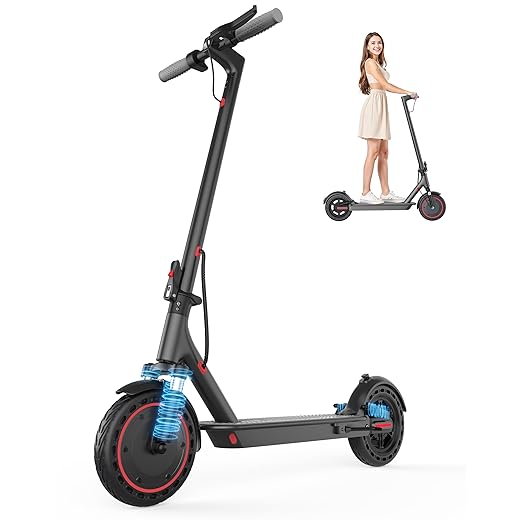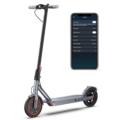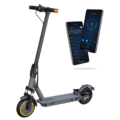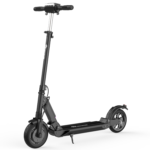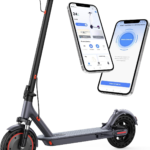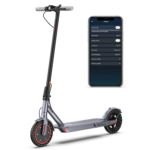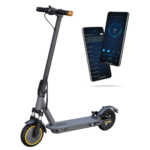- Home
- Scooters
- Electric Scooters
- VOLPAM SPT6
VOLPAM SPT6
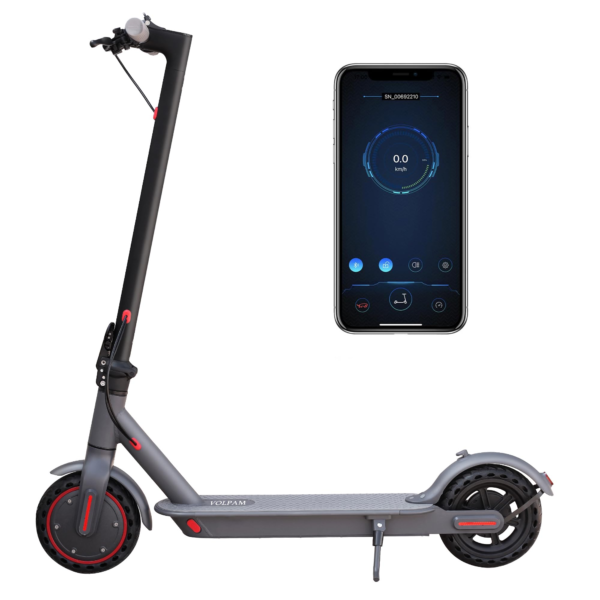

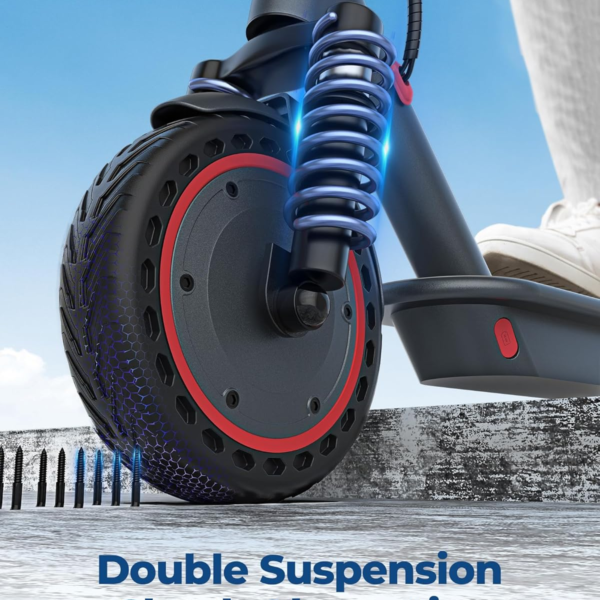
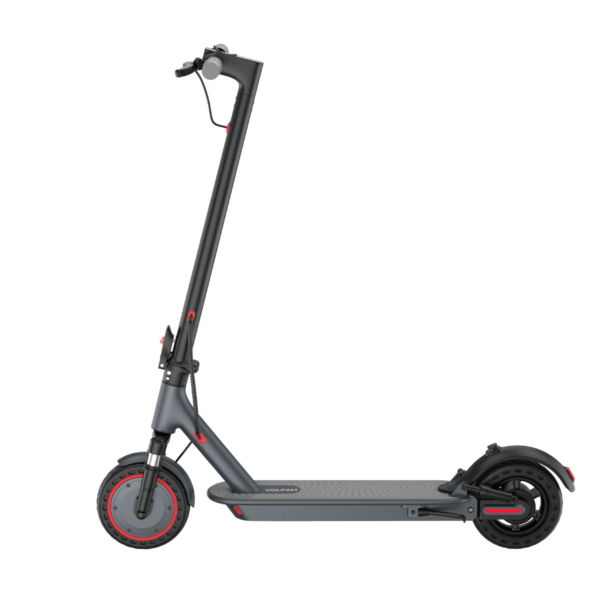
- Battery Range: 23 miles (37 km)
- Top Speed: 19 mph (31 km/h)
- Motor Power: 350 W
- Weight Capacity: 264 lb (120 kg)
- Charging Time: Not specified
- Scooter Weight: Not specified
PROS
- 36V 10.5Ah battery, 23-mile range
- 350W brushless motor
- 8.5″ honeycomb solid tires (no flats)
- Front & rear suspension
- Dual braking and lighting
- Bluetooth app connectivity
CONS
- IP rating not stated
- Exact scooter weight not specified
- Brake hardware type not disclosed
- Solid tires transmit more vibration than pneumatic
Table of contents
- What Is the VOLPAM SPT6?
- How the VOLPAM SPT6 Works
- Key Specifications
- Design & Build Quality
- Performance Fundamentals
- Battery, Range & Efficiency
- Ride Quality & Comfort
- Braking & Safety Features
- Portability & Daily Usability
- Maintenance & Care
- Weather & Seasonal Considerations
- VOLPAM SPT6 vs Alternatives
- Who the VOLPAM SPT6 Is (and Isn’t) For
- FAQs
- Glossary
- Final Thoughts
The VOLPAM SPT6 is a compact, city-friendly electric scooter built around a 350W hub motor, a 36V battery, and 8.5-inch honeycomb solid tires. It targets riders who want a simple, low-maintenance commuter with dual suspension and a steady feel over rough pavement. Moreover, it suits first-time owners who prefer predictable handling, straightforward controls, and official specifications they can verify. Consequently, if you need a calm, confident ride for errands or daily travel, this model fits the brief.
At the same time, its feature set leans commuter-practical rather than flashy. You get front and rear suspension, a dual braking setup, front and rear lighting, and basic smartphone app connectivity. As a result, the scooter feels approachable for new riders yet reliable enough for repeat commutes.
What Is the VOLPAM SPT6?
The VOLPAM SPT6 is a foldable adult e-scooter designed for urban travel. It pairs a brushless 350W hub motor with a 36V, 10.5Ah battery. The brand states a top speed up to 19 mph (30.6 km/h) and a maximum range up to 23 miles (37 km) under ideal conditions. Additionally, honeycomb solid tires aim to remove tube punctures from your routine, while dual suspension helps tame expansion joints and brickwork.
Unlike performance-class models, this scooter sits squarely in the “daily commuter” tier. Therefore, it’s engineered to roll out of your hallway, cover several miles at a time, and fold away again at your destination. The cockpit is intentionally simple. You step on, press the throttle, monitor speed and battery, and go. Meanwhile, maintenance stays light, especially compared to pneumatic-tire models that require regular tube care and tire checks.
How the VOLPAM SPT6 Works
Think of the VOLPAM SPT6 as a compact electric drivetrain wrapped in a practical city chassis. To understand its behavior, it helps to consider each core system.
- Motor: A 350W brushless hub motor sits in a wheel and provides the push. Because brushless motors behave like efficient spinning magnets, they deliver smooth torque, low noise, and minimal service needs.
- Controller: The controller is the scooter’s “brain.” It meters battery power to the motor, interprets throttle input, and coordinates braking logic. In addition, it applies current limits to protect the battery and keep acceleration predictable.
- Battery: A 36V pack rated at 10.5Ah feeds the system. Multiply voltage by amp-hours and you get about 378Wh of energy. Consequently, that capacity underpins the manufacturer’s stated range figures.
- Throttle: The thumb throttle on the handlebar acts like a volume knob for speed. Press a little for a gentle pull-away, press more for stronger acceleration. As a result, most riders become comfortable with it quickly.
- Brakes: The SPT6 uses a dual braking system. You have an electronic brake in the drivetrain and a physical brake at a wheel. Together, they reduce speed while keeping lever feel familiar.
- Suspension: Springs and dampers at the front and rear soak up much of the sharpness from potholes and curb lips. Furthermore, solid honeycomb tires add a bit of compliance without the mess of tubes.
- Lights: A front headlight increases conspicuity ahead, while a red rear light makes you stand out to traffic from behind. Therefore, the basic safety package covers regular dawn and dusk riding.
- App: Smartphone connectivity lets you pair the scooter for basic checks and settings, depending on the brand’s app features for the model. Even so, you can ride confidently without the app after initial setup.
Overall, this is a practical recipe. It favors reliability and routine use over peak speed numbers or exotic hardware, which is exactly what many commuters want.
Key Specifications
The table reflects details published for this model; where the maker does not list an item, it is noted as “Not specified.” This keeps the focus on official specifications and avoids guesswork.
| Block | Item | Detail |
|---|---|---|
| General | Model | VOLPAM SPT6 |
| Intended Use | City / daily commuting | |
| Color | Black | |
| App Connectivity | Yes (pairs with smartphone) | |
| Performance & Power | Motor | 350W brushless hub motor |
| Top Speed | Up to 19 mph (30.6 km/h) | |
| Drive | Hub motor (location not specified) | |
| Hill Grade | Not specified | |
| Battery, Charging & Electrical | Battery | 36V, 10.5Ah (≈378Wh) |
| Claimed Range | Up to 23 miles (≈37 km) | |
| Charging Time | Not specified | |
| Charger | Not specified | |
| Controller | Not specified | |
| Build & Dimensions | Tires | 8.5-inch honeycomb solid tires |
| Suspension | Front and rear suspension | |
| Weight | Not specified | |
| Unfolded Dimensions | Not specified | |
| Folded Dimensions | Not specified | |
| Safety & Control | Braking | Dual braking system (types not fully specified) |
| Lighting | Front headlight and red tail light | |
| IP Rating | Not specified | |
| Reflectors | Not specified | |
| Features & Extras | Display | Not specified |
| Ride Modes | Not specified | |
| Cruise Control | Not specified | |
| Kickstand | Not specified | |
| Warranty & Compliance | Warranty | Not specified |
| Compliance | Follow local regulations; details not specified |
In short, this table shows what’s documented and what isn’t. As a result, you can plan your purchase and maintenance around the known specifications while acknowledging any gaps.
Design & Build Quality
The VOLPAM SPT6 carries a commuter-first silhouette. The deck sits low, which helps stability and makes quick stops feel grounded. Additionally, the stem folds near the deck, so the package becomes easier to pick up and store. Because the tires are honeycomb solids, there are no inner tubes to pinch when you clip a curb or crack. That choice keeps upkeep simple, though it changes ride feel compared to air-filled tires.
Fit and finish aim for tidy seams and straight alignment out of the box. Furthermore, the cable routing is practical. You can trace the brake line and motor wire without a maze of loops. The deck grip is firm underfoot in wet or dry touch, which builds confidence during short hops and long drifts alike. Meanwhile, the cockpit remains uncluttered. Controls sit within thumb reach, so you do not have to adjust your grip to use them.
The dual suspension does more than soften the first hit. It reduces the chatter that tends to fatigue ankles on coarse asphalt. Because solid tires transmit texture to your feet, suspension keeps the deck calmer. Consequently, these parts deliver a ride that newer owners can handle with less learning time.
Performance Fundamentals
City performance is less about raw speed and more about control, consistency, and predictable braking. The VOLPAM SPT6 checks those boxes. The 350W hub motor pulls away with a smooth ramp, which helps in crowded bike lanes. Moreover, power delivery feels linear, so you get steady torque from a walking pace up to cruise.
On 7–10% grades, small commuter scooters like this slow as load rises. The SPT6 behaves similarly. It will crest short hills with a running start and a moderate rider, yet it prefers steady inclines to long, steep climbs. That is typical for a 36V system with a 350W rating. Therefore, for most urban bridges and short ramps, you will be fine. On extended hills, expect cruise speeds to drop into the teens.
Stability matters more than boasting rights. The low deck and solid tires keep the scooter tracking straight through patches of rough pavement. In addition, steering remains neutral, so lane changes do not feel twitchy. In gusts, the scooter wants input from your knees rather than heavy arm steering, which saves upper-body fatigue over longer rides.
Battery, Range & Efficiency
Range claims always depend on the rider, the route, and the weather. The VOLPAM SPT6 uses a 36V, 10.5Ah pack—about 378Wh of energy on paper. The maker quotes up to 23 miles (about 37 km). Achieving the top number usually requires mild temperatures, flat terrain, gentle accelerations, and a lighter rider. Conversely, cold weather, hills, and frequent stops will shorten range.
In common commuter use, you will likely see less than the claimed maximum. Frequent starts and a few hills take a bite. Solid tires are convenient, yet they add a touch of rolling resistance. Consequently, plan your daily route at a middle value and keep a buffer for headwinds or errands. Because the pack is 36V, many riders find a steady cruise in the mid-teens mph to be the most energy-efficient pace.
Charging habits matter. Try to avoid parking the battery at 0% or storing it at 100% for long periods. For day-to-day use, topping up to about 80–90% before riding and not letting it rest depleted helps long-term health. Additionally, if you plan to store the scooter for weeks, park the battery around half charge and set a calendar reminder to check it monthly.
Ride Quality & Comfort
Comfort hinges on three things: tire type, suspension behavior, and cockpit ergonomics. The VOLPAM SPT6 uses 8.5-inch honeycomb solid tires. They will not puncture, and they do not need air checks. That lowers maintenance and removes a common failure point. However, the trade-off is firmer road feel, especially on small chatter and long sections of coarse concrete.
Here, dual suspension takes the edge off those hits. As spring rates settle in, small bumps become less fatiguing, and you can stand longer without foot tingles. Meanwhile, the deck length provides enough room to shift stance on the fly. A diagonal “snowboard” stance helps distribute body weight and unlocks more control over the front wheel. Handlebar reach suits average riders, and the hand controls are where you expect them. Consequently, comfort stays reliable even when surfaces vary.
Noise stays low in normal use. Brushless motors whir rather than growl. Solid tires can hum on certain surfaces, but the tone remains steady. Therefore, the scooter maintains a quiet profile that keeps you a good neighbor on early commutes.
Braking & Safety Features
Brakes define confidence. The VOLPAM SPT6 uses a dual system: electronic braking at the motor and a physical brake at a wheel. Typically, you feel the electronic assist first as mild drag when you start squeezing the lever. As you pull deeper, the mechanical system takes over to deliver stronger bite. Consequently, this two-stage feel helps new riders modulate stops without locking a wheel.
Lighting covers the basics. A forward headlight helps you see and be seen. A red rear light increases your conspicuity to cars and cyclists approaching from behind. For commuters, these lights remain essential at dawn, dusk, and under tree cover. If reflectors are fitted, they further amplify side visibility at intersections.
Riding posture supports safety as much as hardware does. Keep a light bend in elbows and knees, look far ahead, and apply the brakes early rather than late. If your city requires a helmet, wear one. Even if it does not, a helmet remains the best upgrade you can choose.
Portability & Daily Usability
Day-to-day use is where the VOLPAM SPT6 makes its case. It folds quickly, so you can carry it into the office or slide it under a café table. Furthermore, the deck height is modest, which simplifies curb rolls and pedestrian slaloms. Solid tires avoid flats, which keeps your commute schedule predictable.
Storage is equally simple. The folded package fits in a small apartment or car trunk. Keep it out of heavy rain and away from radiators. When you park outside, choose visible places and consider a lock through the deck or stem. As with any commuter scooter, avoid leaving it unattended for long periods in public bike racks; opportunistic theft remains a risk.
Your handling improves as you repeat the route. After a week, you will know which shortcut has smoother pavement and which light favors your timing. Therefore, the SPT6 rewards routine. The more you ride it, the more efficient and confident you become.
Maintenance & Care
Simple habits keep the VOLPAM SPT6 running smoothly. Because routine checks are fast, they are easy to adopt.
- Pre-ride check: Squeeze the brake lever, glance at the headlight, and roll forward to confirm smooth wheel rotation. This takes ten seconds; however, it prevents most surprises.
- Fasteners: Once a month, check stem clamps, axle nuts, and brake hardware. Tighten to firm hand pressure if anything loosens. Do not over-torque; instead, use measured force.
- Brake feel: If lever throw increases, adjust cable slack at the caliper or lever as appropriate for your brake type. Keep pads aligned with the braking surface; otherwise, stopping distances grow.
- Tires: Honeycomb solids do not need air, but inspect for embedded debris that could stress the structure. Replace if cracks appear; safety should come first.
- Battery: Avoid heat. Do not charge immediately after a hot ride. Let the pack cool to room temperature first; consequently, cell longevity improves.
- Firmware/App: If the maker’s app offers updates for the SPT6, apply them with a full battery and the scooter near your phone to keep the connection solid. Even so, skip updates if your unit already behaves as expected.
- Cleaning: Use a damp cloth. Avoid direct high-pressure sprays. Keep electrical connectors dry; moisture and electronics do not mix.
A short maintenance routine beats big repair days. Therefore, ten quiet minutes on a weekend pays back with months of fuss-free commutes.
Weather & Seasonal Considerations
Weather changes the feel and the range of any e-scooter. The VOLPAM SPT6 follows the same physics; therefore, adjust your expectations accordingly.
- Rain: Solid tires resist punctures, yet water reduces grip on paint lines and metal grates. Brake earlier and ride straighter through corners. If the brand does not state a water-resistance rating, avoid heavy rain and standing water.
- Cold: Battery chemistry slows in low temperatures. Expect reduced range below about 50°F (10°C). Store and charge at room temperature when you can; otherwise, capacity drops.
- Heat: High heat shortens battery life. Avoid leaving the scooter in a hot car or a sun-soaked balcony for long periods. Similarly, let the pack cool before charging after a strenuous ride.
- Wind: Headwinds raise energy use. Plan a little extra buffer on blustery days; conversely, tailwinds help extend range.
- Night: The built-in lights help; however, a supplemental clip-on front light and a reflective ankle band increase visibility if local roads are dim.
Seasonal awareness is part of safe commuting. As a result, you will ride more smoothly and conserve energy across changing conditions.
VOLPAM SPT6 vs Alternatives
Commuter scooters fall into a few broad families. The VOLPAM SPT6 sits in the “350W, 36V, 8.5-inch solid tire” class with dual suspension. Here is how it stacks up conceptually:
- Against lighter last-mile scooters: It rides steadier at cruise thanks to suspension at both ends and a larger battery. Additionally, it offers a higher claimed range for the weight.
- Against bigger commuters with pneumatic tires: It is simpler to own. You will not patch tubes or manage air pressure. By contrast, ride comfort on large bumps favors air tires, but maintenance tilts toward solids.
- Against performance scooters: It is far lighter and easier to carry. Peak speed and hill stamina are lower, which matters on very steep routes. Nevertheless, for flat cities, this rarely becomes a deal-breaker.
- Against off-road-style models: The SPT6 is narrower and more nimble in traffic. Trail-focused hardware brings weight and cost that daily commuters may not use; consequently, the SPT6 keeps things practical.
If your rides mix sidewalks, bike lanes, and short road stretches, the SPT6’s balance of ease and stability makes sense. However, if you regularly climb long, steep hills, a higher-power class will hold speed better.
Alternatively, if your budget is capped and you’re just exploring entry-level picks, check out the 5 best electric scooters under $200 in 2025 for clear expectations on what sub-$200 models typically deliver.
Who the VOLPAM SPT6 Is (and Isn’t) For
The VOLPAM SPT6 suits riders who value predictability over flash. It is a fit for students, office commuters, and multi-modal travelers who hop between scooter and transit. Additionally, it works well for short grocery runs and errands where storage space is tight.
If you want an even simpler, budget-first option for short hops, the VOLPAM Q1 can fit that role for shorter distances and lighter loads.
If you want a carefree maintenance plan, solid tires help. If you must carry the scooter up stairs, the compact fold helps again. New riders will appreciate the gentle throttle ramp and the planted ride. Therefore, beginners often settle in quickly.
It is not aimed at thrill seekers or heavy cargo haulers. It also is not the ideal match for daily mountain climbs. Instead, the scooter’s strengths show up on normal city routes a few miles long, repeated many times per week.
FAQs
1) Is the VOLPAM SPT6 good for daily commuting?
Yes. It offers steady handling, simple controls, and low-upkeep tires. Additionally, the dual suspension smooths rough pavement, which reduces fatigue on repeat trips.
2) What is the real-world range?
Range depends on rider weight, route, speed, and temperature. The maker quotes up to 23 miles (about 37 km). However, expect less in cold weather or hilly areas, especially with frequent stops.
3) How fast does it go?
The brand lists a top speed up to 19 mph, which is about 30.6 km/h. Even so, many riders cruise a little below that for comfort and efficiency.
4) Does it have cruise control?
The manufacturer does not specify cruise control for this model. Therefore, treat it as unavailable unless documentation for your unit confirms otherwise.
5) What maintenance does it need?
Check brake feel monthly, inspect the tires, and keep fasteners snug. Moreover, wipe the scooter clean with a damp cloth and avoid high-pressure sprays.
6) Where can I find an official VOLPAM SPT6 overview?
The best overview comes from the model’s official materials. Consequently, rely on manufacturer documentation to verify items like top speed, range, tire type, and lighting.
7) Can I ride it in the rain?
The brand does not publish a water-resistance rating for this model. Therefore, use caution in light rain, avoid deep puddles, and store the scooter indoors to protect the electronics.
Glossary
- Ah (Amp-hours): Battery capacity measurement. Higher Ah suggests more stored energy at the same voltage.
- Wh (Watt-hours): Energy content, calculated as volts × amp-hours. As a result, it is a better apples-to-apples metric than Ah alone.
- Controller: The electronic unit that meters battery power to the motor and interprets throttle and brake inputs.
- Brushless Motor: A motor without brushes that reduces wear and improves efficiency. Consequently, it dominates modern e-scooters.
- Hub Motor: A motor built into the wheel hub. It saves space and needs little maintenance.
- Regen (Electronic Braking): Motor-based braking that creates drag and may recover a small amount of energy; however, recovery is typically modest.
- Stem Flex: The bending you feel at the handlebar when hitting bumps. Less flex feels more precise.
- IP Rating: A code describing dust and water protection. If not published, assume only light splash resistance.
- Honeycomb Tire: A solid tire with internal holes that mimic some shock absorption of air tires without punctures.
- Ride Mode: A preset that limits speed or changes throttle response. In practice, it tailors behavior to conditions.
- Kickstand: A side support that holds the scooter upright when parked.
- Voltage (V): Electrical potential of a battery pack. Common scooter packs are 36V or 48V.
- Amp (A): The flow of electrical current, managed by the controller based on throttle input.
- Torque: The twisting force that turns the wheel, controlling off-the-line pull and hill starts.
- Thermal Throttling: Power reduction by the controller to protect electronics when they get hot. As a result, speed and acceleration may momentarily drop.
Final Thoughts
The VOLPAM SPT6 focuses on the fundamentals. It blends an approachable motor with a practical battery, solid tires, and suspension at both ends. Consequently, the scooter is steady on imperfect pavement and easy to live with day after day. It keeps your routine simple while covering the miles most commuters need. If that sounds like your use case, this model deserves a close look.
Keep in mind that the manufacturer does not list every detail for the SPT6. Even so, the critical pieces are clear: 350W propulsion, a 36V 10.5Ah battery, a claimed 19 mph top speed, up to 23 miles of range, dual suspension, dual braking, lighting, and app pairing. Taken together, those official specifications outline a reliable city runabout that prioritizes predictability over flash.
Specifications
General
| Model The Model specifies the exact version or name of the scooter. It helps identify its unique design, features, and specifications within the manufacturer’s product line. Knowing the model makes it easier to compare options, find compatible accessories, or look up support information. | SPT6 |
| Brand The Brand identifies the manufacturer or company that designs and produces the scooter. A trusted brand is a sign of quality, reliability, and good customer support. Well-known brands often have higher standards for safety, performance, and after-sales service, giving you more confidence in your purchase. | VOLPAM |
| Release Date The Release Date indicates when the scooter model was officially launched on the market. This helps you know how current the design, technology, and features are. A newer release date often means updated components, improved performance, and the latest safety or smart features. | 17 November 2025 |
| Recommended Age Recommended Age indicates the minimum age range that the scooter is designed for, based on safety, size, and ease of use. Following the recommended age helps ensure that riders can handle the scooter’s speed, weight, and controls comfortably and safely. Always check local laws and use protective gear, especially for younger riders. | +16 |
Performance & Power
| Motor Power (Wattage) What it means: The motor power, measured in watts (W), shows how strong the scooter’s electric motor is. Why it matters: Higher wattage usually means better acceleration, more torque, and improved performance on hills or rough terrain. For example, a 250W motor is good for flat city roads and light riders, while a 500W or 1000W motor provides more power for faster speeds or climbing steep inclines. | 350 W brushless hub motor |
| Top Speed The Top Speed indicates the maximum speed that the scooter can reach under optimal conditions. It’s usually measured on level ground with a fully charged battery and an average rider weight. A higher top speed allows you to travel longer distances faster, but always ensure you ride within legal speed limits and your personal comfort zone for safety. | 19 mph (31 km/h) |
| Battery Capacity Battery Capacity refers to the total amount of energy the scooter’s battery can store, usually measured in ampere-hours (Ah) or watt-hours (Wh). A higher battery capacity means you can ride longer distances on a single charge, reducing the need for frequent recharging. Keep in mind that actual range can vary depending on rider weight, terrain, speed, and weather conditions. | 36 V 10.5 Ah (378 Wh) |
| Estimated Range per Charge The Estimated Range per Charge indicates the average distance the scooter can travel on a single full battery charge. This range is calculated under optimal conditions, such as flat terrain, moderate speed, and average rider weight. Real-world range may vary depending on riding style, terrain, weather, and load. A longer range means fewer recharges and greater freedom for longer trips. | 23 miles (37 km) |
| Hill Climb Ability Hill Climb Ability describes the maximum incline or slope that the scooter can handle while maintaining stable performance. It’s typically expressed as a percentage or in degrees. A higher hill climb rating means the scooter can tackle steeper hills without losing too much speed or power. Actual climbing performance may vary based on rider weight, battery charge, and terrain conditions. | Not specified |
| Drive System The Drive System refers to how power from the motor is delivered to the wheels. Electric scooters typically use either a hub motor (directly integrated into the wheel) or a chain/belt drive system. A high-quality drive system ensures smooth acceleration, efficient power transfer, and low maintenance. The choice of drive system affects performance, noise level, and overall ride experience. | Not specified |
Charging & Electrical
| Charging Time Charging Time indicates how long it takes to fully recharge the scooter’s battery from empty to 100% using the standard charger provided. Faster charging means less downtime and more time on the road. Actual charging time may vary slightly depending on battery capacity, charger output, and environmental conditions. | Not specified |
| Battery Type Battery Type refers to the specific technology used in the scooter’s battery, which affects performance, lifespan, weight, and charging time. Most modern electric scooters use high-quality lithium-ion (Li-ion) batteries because they offer a good balance of energy density, durability, and low maintenance. A reliable battery type ensures consistent power delivery and longer riding ranges. | Lithium-ion pack with BMS |
| Removable Battery A Removable Battery means the battery pack can be easily detached from the scooter for convenient charging and replacement. This feature allows you to charge the battery separately, swap it with a spare for extended range, or securely store it indoors in extreme weather. Removable batteries add flexibility and make it easier to keep your scooter powered up wherever you are. | Non-removable internal battery (fixed pack) |
| Regenerative Braking Regenerative Braking is an energy-saving feature that converts some of the energy normally lost during braking back into battery power. When you slow down or brake, the motor works in reverse to generate electricity, which helps extend the scooter’s range and improves overall efficiency. This system also reduces wear on traditional brake components, leading to lower maintenance over time. | Not specified |
| Lighting Lighting refers to the built-in front and rear lights that enhance visibility and safety when riding in low-light conditions or at night. Good lighting helps you see the road ahead and ensures that other road users can see you. Many scooters include LED headlights, taillights, and sometimes brake lights or side reflectors for added safety and compliance with local traffic regulations. | LED headlight + rear LED/brake |
Build & Dimensions
| Scooter Weight Scooter Weight refers to the total weight of the scooter when fully assembled, including the battery. This affects how easy it is to carry, lift, and store the scooter when not in use. A lighter scooter is more portable and convenient for commuting, especially if you need to carry it upstairs or onto public transport. Keep in mind that a sturdy frame and quality components may add to the weight but also contribute to better durability and ride stability. | Not specified |
| Maximum Rider Weight Maximum Rider Weight indicates the highest rider weight that the scooter is designed to safely support while maintaining optimal performance and stability. Staying within this limit helps ensure reliable acceleration, braking, and climbing ability, and it protects the frame, suspension, and motor from excessive strain. Exceeding the recommended limit may reduce performance and increase wear on components. | 264 lb (120 kg) |
| Deck Size Deck Size refers to the dimensions of the scooter’s standing platform. A wider and longer deck provides more foot space, allowing you to stand comfortably and adjust your stance while riding. A well-sized deck improves balance and stability, especially on longer rides or at higher speeds. Compact decks, on the other hand, help keep the scooter lightweight and portable. | City commuter geometry; dual-shock layout |
| Handlebar Height Handlebar Height refers to the distance from the deck to the handlebars, which affects your riding posture and comfort. An appropriate handlebar height helps you maintain good balance, reduces strain on your back and arms, and makes steering more comfortable. Some scooters have adjustable handlebars to fit riders of different heights, while others have a fixed height for a streamlined design. | Fixed |
| Folding Mechanism The Folding Mechanism describes how easily and securely the scooter can be folded for carrying and storage. A well-designed folding system lets you quickly collapse the scooter into a compact size, making it convenient to transport on public transit, store under a desk, or fit into a car trunk. Look for sturdy latches and safety locks to ensure the scooter stays firmly in place when folded or unfolded. | One-step folding latch |
| Dimensions Folded Dimensions indicate the size of the scooter when it’s fully folded. This measurement shows how much space the scooter will take up when stored or carried, making it easier to check if it will fit in your car trunk, under a desk, or in a closet. Compact folded dimensions are ideal for commuters who need to bring their scooter on public transport or store it in tight spaces. | Folded: Not specified; Unfolded: Not specified |
| Material Material refers to the primary construction materials used for the scooter’s frame and key components. High-quality materials like aircraft-grade aluminum, reinforced steel, or durable composites provide strength, stability, and a lighter overall weight. A sturdy material ensures the scooter can handle daily wear and tear while maintaining safety and performance. | Aluminum alloy |
Safety & Control
| Brake Type(s) Brake Type(s) describe the braking systems the scooter uses to help you slow down or stop safely. Common brake types include mechanical brakes (like drum or disc brakes), electronic brakes, and foot brakes. Many scooters combine multiple braking systems for added safety and shorter stopping distances. The type and quality of brakes affect your control, especially when riding at higher speeds or on slopes. | Dual braking (mechanical + electronic) |
| Suspension Suspension refers to the system that absorbs shocks and vibrations while riding, providing a smoother and more comfortable ride over uneven or rough surfaces. Scooters may have front suspension, rear suspension, or dual suspension for better shock absorption and stability. Good suspension helps reduce rider fatigue and improves control, especially when riding on bumpy roads or off-road paths. | Front & rear |
| Tire Type Tire Type refers to the kind of tires the scooter uses, which directly affects ride comfort, traction, and maintenance. Common types include solid (airless) tires, pneumatic (air-filled) tires, or hybrid options. Pneumatic tires offer better shock absorption and a smoother ride on rough surfaces, while solid tires are puncture-proof and require less upkeep. The right tire type helps ensure safe handling and a comfortable ride in different conditions. | 8.5″ honeycomb solid tires |
| Tire Size Tire Size indicates the diameter and width of the scooter’s tires, which affect ride comfort, stability, and how well the scooter handles different terrains. Larger tires generally offer better shock absorption and a smoother ride over bumps and rough surfaces, while smaller tires keep the scooter lighter and more portable. Choosing the right tire size helps ensure a balance between agility and comfort. | 8.5-inch |
| Kickstand The Kickstand is a built-in stand that allows you to park your scooter upright when it’s not in use. A sturdy kickstand keeps the scooter stable and prevents it from tipping over, protecting it from scratches and damage. It also makes storing and accessing your scooter more convenient, whether you’re at home, work, or on the go. | Not specified |
| Water Resistance Rating Water Resistance Rating indicates how well the scooter is protected against water and moisture, usually shown as an IP (Ingress Protection) rating. This rating helps you understand whether the scooter can handle light rain, splashes, or wet roads without damage. While most scooters are not fully waterproof, a good water resistance rating adds peace of mind when riding in changing weather conditions. Always avoid deep puddles or submerging the scooter to protect its electrical components. | Not specified |
Features & Extras
| Display/Console The Display (or Console) shows important real-time information about your ride, helping you monitor your scooter’s status at a glance. Typical displays show speed, battery level, distance traveled, and riding mode. Some models also include additional features like Bluetooth connectivity, app integration, or backlighting for better visibility at night. A clear and easy-to-read display enhances safety and convenience on every trip. | LED display with speed, battery, mode |
| Ride Modes Ride Modes refer to the different speed and power settings you can choose to match your riding style or road conditions. Common modes include eco for maximum range and energy efficiency, standard for everyday balance, and sport or turbo for higher speed and stronger acceleration. Switching between ride modes allows you to customize performance, conserve battery, and ride safely in various environments. | Not specified |
| Smart App Connectivity Smart App Connectivity lets you pair your scooter with a dedicated mobile app via Bluetooth. Using the app, you can monitor real-time ride stats like speed, battery level, and range, adjust settings such as ride modes or cruise control, lock the scooter for added security, and sometimes receive firmware updates. This feature adds convenience and allows you to personalize your riding experience right from your smartphone. | Bluetooth app (status, lock, basic settings) |
| Anti-Theft System The Anti-Theft System helps protect your scooter from unauthorized use or theft. This feature can include built-in alarms, electronic motor locks, GPS tracking, or remote locking through a mobile app. A good anti-theft system provides peace of mind when parking your scooter in public spaces, adding an extra layer of security to safeguard your investment. | App lock |
| Cruise Control Cruise Control allows you to maintain a steady speed without continuously holding the throttle. This feature makes longer rides more comfortable by reducing hand fatigue and providing a smoother, more relaxed riding experience — especially on flat, open roads or bike lanes. For safety, cruise control can usually be easily activated or deactivated while riding. | Not specified |
| Accessories Included Accessories Included lists the additional items that come with the scooter to enhance your riding experience and convenience. Common accessories may include a charger, kickstand, bell, lights, phone holder, or carrying strap. These extras add value by making your scooter safer, easier to use, and ready to ride straight out of the box. | Scooter, charger, tools, manual (charger spec not specified) |
Warranty & Compliance
| Warranty Period The Warranty Period indicates how long the manufacturer guarantees the scooter against defects in materials and workmanship under normal use. A good warranty provides peace of mind, showing the brand’s confidence in its product quality. Always check what parts are covered, such as the frame, battery, and motor, and follow the maintenance guidelines to keep your warranty valid. | 12 months (region-dependent) |
| Certifications Certifications confirm that the scooter meets specific safety, quality, and environmental standards set by recognized organizations or regulatory bodies. Common certifications may include CE, RoHS, UL, or other local compliance marks, depending on your region. These certifications ensure that the scooter is manufactured to high standards and is safe and legal to use in your country. | Local micromobility compliance; UL status not specified |



